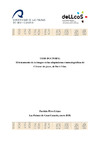Identificador persistente para citar o vincular este elemento:
https://accedacris.ulpgc.es/jspui/handle/10553/77438
| Título: | El tratamiento de la imagen en las adaptaciones cinematográficas de L’écume des jours, de Boris Vian | Autores/as: | Pérez López, Patricia | Director/a : | Clouet, Richard | Clasificación UNESCO: | 620301 Cinematografía 6202 Teoría, análisis y crítica literarias |
Palabras clave: | Cinema Literature Adaptation Paraadaptation Culture, et al. |
Fecha de publicación: | 2018 | Resumen: | L’écume des jours, de Boris Vian es una novela escrita de marzo a mayo de 1946 y publicada al año siguiente. Esta historia con toques surrealistas, que no es una historia de amor al uso, ha sido adaptada en muchos campos, como el cine y el teatro, y en muchos países, pero el hecho que ha despertado el interés de este trabajo es la adaptación al cine. Después de haber leído la novela en versión original y traducida, y conocer la adaptación cinematográfica que hizo Gondry en 2013, descubrimos la de Belmont, de 1968. La gran pregunta antes de ver ambas adaptaciones fue, ¿cómo se puede llevar al cine una obra con tanta carga surrealista? ¿Será posible recoger las creaciones de Vian en la gran pantalla? Y, de ser así, ¿no será, cuanto menos, raro, ver esos artilugios que nuestra mente ha creado a su manera? Por otra parte, hay una gran carga personal y cultural en la obra de Vian, ¿será esta recogida en sus adaptaciones cinematográficas para poder ser transmitidas al espectador como al lector? Y, por último, si no las recoge, ¿podemos llamarlas adaptaciones o habremos de elegir otro término? Para responder a todas estas preguntas, de las que surge la hipótesis de este trabajo de investigación, hemos hecho, en primer lugar, un recorrido por distintas teorías que enlazan cine y literatura, analizando mecanismos de narración, tiempo, espacio y lenguaje en ambas disciplinas. También hemos hecho un estudio de las imágenes, de modo teórico, y luego aplicado a la obra, pues de ellas se sirve el escritor para transmitir una realidad que critica. Dichas imágenes las hemos contrastado con las adaptaciones cinematográficas o «paraadaptaciones» –término creado en esta investigación¬¬– para sacar conclusiones sobre las diferencias y similitudes, en cada uno de los casos, que pueden estar relacionadas, además, con las diferencias en los contextos culturales de cada época de creación. Por último, exponemos las conclusiones relacionando la teoría y la práctica mencionada sobre estas líneas y a lo largo de todo el trabajo. L’écume des jours is a Boris Vian novel written from March to May 1946 and published the following year, 1947. Even though the author did not like to be tagged as a surrealist, it is indeed a story with surrealist touches that will not leave indifferent those who read it. The year of its publication, the novel did not get the success expected by Boris Vian. But from the 60’s, it gets a privileged place in France, even getting to be included in children’s reading program in French educational establishments several years later. This story, far from an ordinary love story, has been adapted to fields such as cinema and theatre, and in many countries. However, it was its film adaptation which awaked the interest of this research. After having read the novel in its original version and its Spanish translation, and knowing the film adaptation made by Gondry in 2013, we discovered Belmont’s of 1968. The most important question before watching both adaptations was: how can somebody adapt a novel with so many surrealist elements for film? Is it possible to adapt Vian’s inventions? And, if so, wont’t it be strange to see those inventions we have created in our minds, in otherways? Apart from that, there is a big amount of personal and cultural content in Vian’s novel. Is this reflected in film adaptations in order to be transmitted to spectators the sameway as toreaders? And, finally, if not, can we call them adaptations or must we choose another term instead? To be able to answer all these questions, from which the hypothesis of this research arises, first of all, we have gone over the different theories joining cinema and literature and then we have analyzed narrative, time, space and language mechanisms in both disciplines. We have also analysed images in a theoretical way and we have applied this to the novel because the writer uses these images to transmit a reality criticized by himself. Such images have been contrasted with those of film adaptations or what we call “paraadaptations” (paraadaptaciones) – term created in this research–, in order to draw conclusions about the differences and the similarities in each case that could be also connected to the differences in cultural contexts of every creation time. At last, we present the conclusions of this research connecting the theory and the practice mentioned above and along this research. |
Descripción: | DELLCOS. Doctorado en estudios lingüísticos y literarios en sus contextos socioculturales | URI: | https://accedacris.ulpgc.es/handle/10553/77438 |
| Colección: | Tesis doctoral |
Visitas
227
actualizado el 24-ago-2024
Descargas
720
actualizado el 24-ago-2024
Google ScholarTM
Verifica
Comparte
Exporta metadatos
Los elementos en ULPGC accedaCRIS están protegidos por derechos de autor con todos los derechos reservados, a menos que se indique lo contrario.
